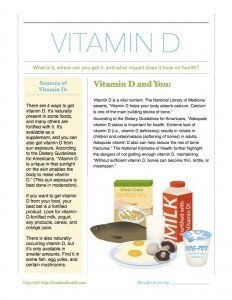Vitamin D and the Dietary Guidelines
 Here's the last installment of the Dietary Guidelines Nutrients of Concern series. Since the guidelines advise people to "Choose foods that provide more potassium, dietary fiber, calcium, and vitamin D, which are nutrients of concern in American diets," we've focused on discussing one of these nutrients per week. Want to catch up? Here are the previous installments...
Here's the last installment of the Dietary Guidelines Nutrients of Concern series. Since the guidelines advise people to "Choose foods that provide more potassium, dietary fiber, calcium, and vitamin D, which are nutrients of concern in American diets," we've focused on discussing one of these nutrients per week. Want to catch up? Here are the previous installments...
This week, let's talk about vitamin D.What Is It?Vitamin D is a fat-soluble vitamin that is vital to good health. Where Can You Get It?There are 4 ways to get vitamin D. It's naturally present in some foods, and many others are fortified with it. It's available as a supplement, and you can also get vitamin D from sun exposure. According to the Dietary Guidelines for Americans, "Vitamin D is unique in that sunlight on the skin enables the body to make vitamin D." This sun exposure is best done in moderation, so that you don't raise your risk of skin cancer at the same time.If you want to get vitamin D from your food, your best bet is a fortified product. Look for vitamin-D-fortified milk, yogurt, soy products, cereal, and orange juice as good dietary sources of this nutrient. In fact, "In the United States, most dietary vitamin D is obtained from fortified foods, especially fluid milk and some yogurts" (source).There is also naturally-occurring vitamin D, but it is generally harder to digest and less available. However, you can find it in the following foods...
Where Can You Get It?There are 4 ways to get vitamin D. It's naturally present in some foods, and many others are fortified with it. It's available as a supplement, and you can also get vitamin D from sun exposure. According to the Dietary Guidelines for Americans, "Vitamin D is unique in that sunlight on the skin enables the body to make vitamin D." This sun exposure is best done in moderation, so that you don't raise your risk of skin cancer at the same time.If you want to get vitamin D from your food, your best bet is a fortified product. Look for vitamin-D-fortified milk, yogurt, soy products, cereal, and orange juice as good dietary sources of this nutrient. In fact, "In the United States, most dietary vitamin D is obtained from fortified foods, especially fluid milk and some yogurts" (source).There is also naturally-occurring vitamin D, but it is generally harder to digest and less available. However, you can find it in the following foods...
- Egg yolks
- Herring
- Mackerel
- Salmon
- Some types of mushrooms
- Tuna
 What Impact Does Vitamin D Have on Health?Vitamin D is a vital nutrient. The National Library of Medicine has catalogued its role in the body, asserting, "Vitamin D helps your body absorb calcium. Calcium is one of the main building blocks of bone. A lack of vitamin D can lead to bone diseases such as osteoporosis or rickets." The National Institutes of Health add more detail, explaining "Vitamin D promotes calcium absorption in the gut and maintains adequate serum calcium and phosphate concentrations to enable normal mineralization of bone and to prevent hypocalcemic tetany. It is also needed for bone growth and bone remodeling by osteoblasts and osteoclasts." In other words, vitamin D plays a key role in the health of your bones and teeth.Of course, that's not all it does. It's also integral to your immune system, your muscles, and your nervous system. What a versatile nutrient!
What Impact Does Vitamin D Have on Health?Vitamin D is a vital nutrient. The National Library of Medicine has catalogued its role in the body, asserting, "Vitamin D helps your body absorb calcium. Calcium is one of the main building blocks of bone. A lack of vitamin D can lead to bone diseases such as osteoporosis or rickets." The National Institutes of Health add more detail, explaining "Vitamin D promotes calcium absorption in the gut and maintains adequate serum calcium and phosphate concentrations to enable normal mineralization of bone and to prevent hypocalcemic tetany. It is also needed for bone growth and bone remodeling by osteoblasts and osteoclasts." In other words, vitamin D plays a key role in the health of your bones and teeth.Of course, that's not all it does. It's also integral to your immune system, your muscles, and your nervous system. What a versatile nutrient! What Happens When You Don't Get Enough Vitamin D?Ah, there's the rub. Since vitamin D is so important to building strong bones, not getting enough of it can seriously weaken your bones. The Dietary Guidelines for Americans insist, "Adequate vitamin D status is important for health. Extreme lack of vitamin D (i.e., vitamin D deficiency) results in rickets in children and osteomalacia (softening of bones) in adults. Adequate vitamin D also can help reduce the risk of bone fractures." The National Institutes of Health further highlight the dangers of not getting enough vitamin D, maintaining, "Without sufficient vitamin D, bones can become thin, brittle, or misshapen."Make sure you get enough vitamin D every day. The recommended daily allowances (RDAs)* for vitamin D are as follows...
What Happens When You Don't Get Enough Vitamin D?Ah, there's the rub. Since vitamin D is so important to building strong bones, not getting enough of it can seriously weaken your bones. The Dietary Guidelines for Americans insist, "Adequate vitamin D status is important for health. Extreme lack of vitamin D (i.e., vitamin D deficiency) results in rickets in children and osteomalacia (softening of bones) in adults. Adequate vitamin D also can help reduce the risk of bone fractures." The National Institutes of Health further highlight the dangers of not getting enough vitamin D, maintaining, "Without sufficient vitamin D, bones can become thin, brittle, or misshapen."Make sure you get enough vitamin D every day. The recommended daily allowances (RDAs)* for vitamin D are as follows...
- 600 IU (15 mcg) per day for children
- 600 IU (15 mcg) per day for most adults
- 800 IU (20 mcg) per day for adults over the age of 70
When it comes to vitamin D, there can also be too much of a good thing. Overconsuming vitamin D can lead to serious health complications. For best health, make sure to stick to your RDA.Here's the final Dietary Guidelines Nutrients of Concern handout -- how will you use your copy? Here are some of the most popular vitamin D resources! And, as always, there's more in the Nutrition Education Store!
Here are some of the most popular vitamin D resources! And, as always, there's more in the Nutrition Education Store!

 *These numbers assume minimal sun exposure.
*These numbers assume minimal sun exposure.